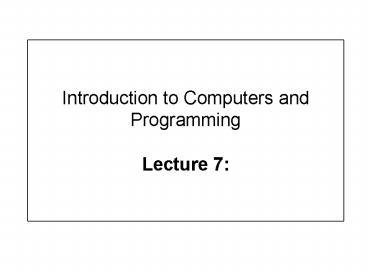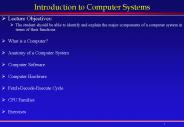Introduction to Computers and Programming Lecture 7: - PowerPoint PPT Presentation
1 / 13
Title:
Introduction to Computers and Programming Lecture 7:
Description:
In Java, there are many more characters available then in the basic ascii table. The ascii table only has 128 characters in it. ... – PowerPoint PPT presentation
Number of Views:31
Avg rating:3.0/5.0
Title: Introduction to Computers and Programming Lecture 7:
1
Introduction to Computers and ProgrammingLecture
7
2
Road map
- char data type
3
Review
- True or False An int variable can contain any
integer. - When must you use an if / else if / else
statement instead of using a switch statement? - When is it preferable to use a switch statement?
- What is a magic number? How should you deal with
a magic number? Why? - Explain what the exclusive or () operator tests.
- (exp a) (exp b)
- Define the purpose of each part of this
expression - (part a) ? (part b) (part c)
4
Review continued
- What is the output of the following code
fragment? - int a 100, b 50
- if ((a 60) (b lt 100))
- System.out.println ("Yes")
- What is the output of the following code
fragment? - int a 100, b 50
- if ((a 60) (b lt 100))
- System.out.println ("Yes")
5
Review continued
- What is the output of this switch statement?
- int a 90
- switch (a)
- case 80
- System.out.println (80)
- case 90
- System.out.println (90)
- case 100
- System.out.println (100)
6
char data type
7
char data type
- Java allows us to store "single" character
values. - char character 'a' // not the same as "a"
- char character '7'
- char newline '\n'
- char tab '\t'
- char space ' '
- The characters are actually stored as integers
(ascii values). - See http//asciitable.com/
- Note chars use single quotes. We have seen that
Strings use double quotes.
8
ASCII Table
Source Liang
9
char arithmetic
- Given
- char letter 'a'
- The following code
- letter (char) (letter 1)
- Would result in letter storing a 'b' character.
- If we add or subtract two char values, the result
is an int value. - For example 'c' 'a' would result in the value 2.
10
Casting between char and int values
- A char uses 16 bits of memory.
- You can implicitly cast a char to an int
- char c 'a'
- int i c
- You must explicitly cast an int to a char
- int i 65
- char (char) i
- Note Even though chars are equal to shorts in
the amount of memory they use, they do not hold
the same values (shorts can hold negative
numbers).
11
Reading char values from the user
- You should use charAt(0) to parse the character
from user input. - For example
- char c
- String cAsString
- cAsString JOptionPane.showInputDialog (null,
"Enter a character") - c cAsString.charAt(0)
- Will grab the first character from the user's
input.
12
Warning about numeric digit characters
- The value of a the single digit numeric
characters are not equivalent to the values
themselves. In fact the ASCII value of '0' is
48, '1' is 49, , '9' is 57. - How do you think we could convert a numeric char
to an int?
13
Unicode
- In Java, there are many more characters available
then in the basic ascii table. - The ascii table only has 128 characters in it.
- Java uses 2 bytes to store characters which
allows it to hold 65536 unique characters. - Java can store any Unicode (see unicode.org)
character in a char variable. - That means you can print any character from any
language on any platform. - To print a Unicode character, use '\uxxxx' where
xxxx is a hexadecimal representation of the
Unicode for the desired character.































